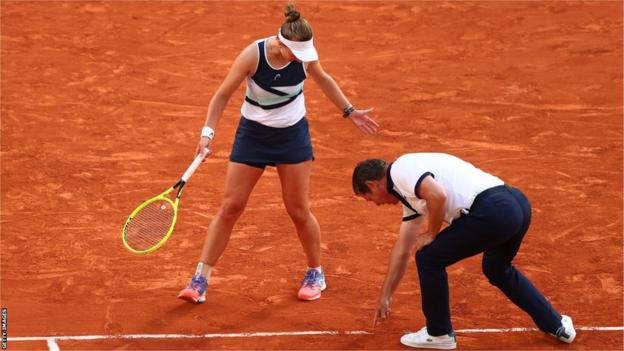Seeing a chair umpire jump down to the court, scamper across the clay and point out the mark of a ball is one of the great traditions of the French Open.
The scene adds to the spectacle. A sense of anticipation hangs in the air, whistles or cheers from the Paris crowd – depending who the decision is for – accompany the official to the spot.
But, in a sport of high stakes and fine margins, is it time to stop relying solely on the human eye to decide crucial points?
At the recent Italian Open, Britain’s Andy Murray was annoyed when a line call went against him because the umpire ruled the ball mark was on the line.
Murray strongly disagreed. Electronic line calling technology – not used at the Rome tournament but seen by television viewers – supported the former world number one’s view.
The incident reignited a long-running debate whether an electronic system should be brought on to all courts – including Roland Garros’ famous terracotta surfaces.
Is the technology unreliable on clay?
Unlike the other three Grand Slam tournaments, which are played on hard or grass courts, the French Open does not use the technology in any form.
The Australian Open and US Open – both played on hard courts – have already dispensed with human line judges in favour of solely relying on automated calls.
Wimbledon, played on grass, introduced Hawk-Eye technology in 2007 but the line judges remain. Players at the Championships are able to challenge calls up to three times per set.
The French Open continues to fully trust line judges and umpires, not allowing players to use electronic replays to challenge human decision.
For a long time it has been felt the red brick dust – a top layer of one to two millimetres – compromises the accuracy and reliability of an electronic system because it is a ‘live’ surface which moves during the match.
That has led to continuing issues of confidence from players, commentators and fans.
But Foxtenn – one of three systems used to judge line calls in tennis, alongside Hawk-Eye and IMG Arena – insists it is reliable.
Foxtenn is the only vendor which has so far operated an electronic line calling system on clay courts.
It says its ‘real bounce technology’ – which uses ultra-high-speed cameras capable of generating more than 100,000 images per second in combination with a laser scanner system – is suitable for the surface.
“It…
Click Here to Read the Full Original Article at BBC Sport – Tennis…

